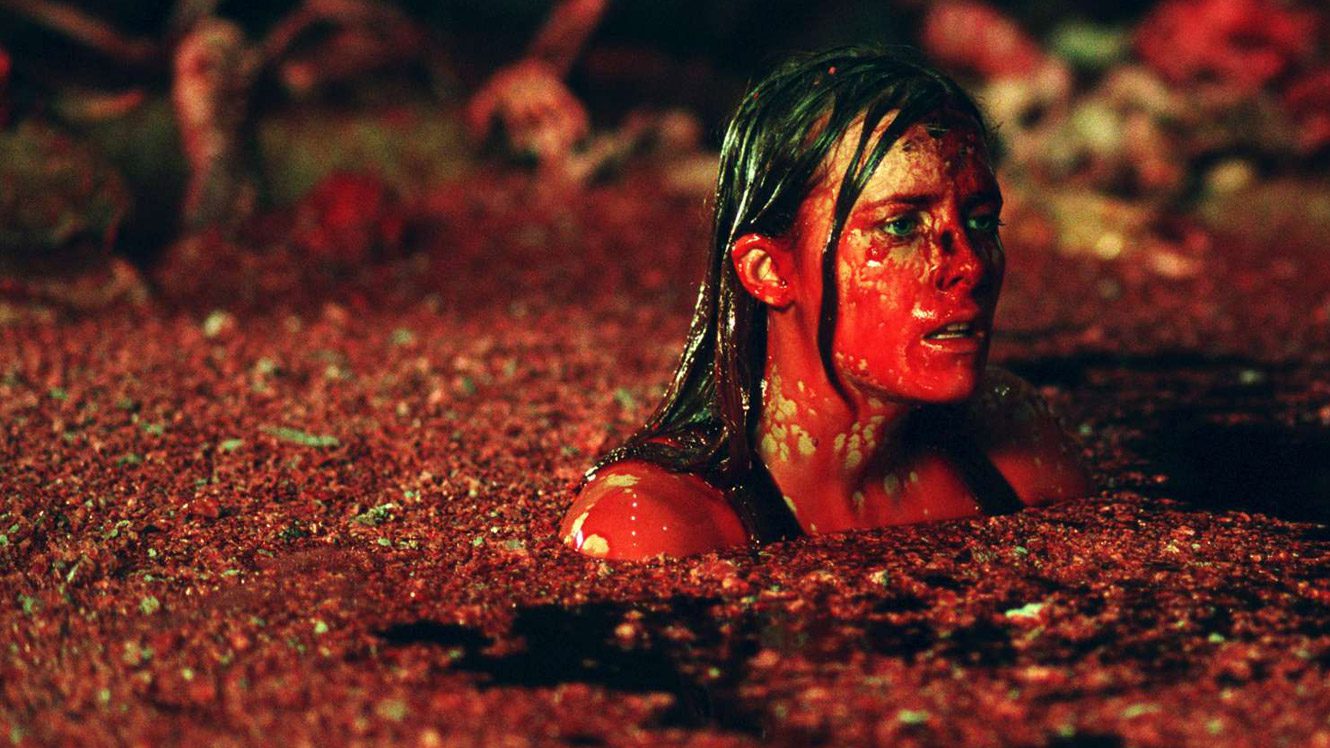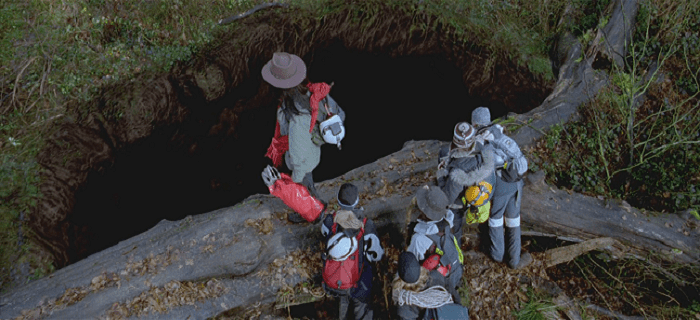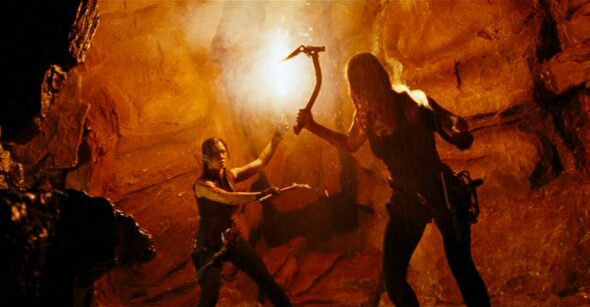“The worst thing that could have happened to you has already happened.”
The Descent has a title that can be interpreted in a few ways. First, there’s the literal interpretation, regarding the actual descent that a group of women make into an uncharted cave. But there’s also a metaphorical interpretation: the word “descent” is often followed by “into madness,” and beyond that the title describes the sudden downshift from trauma to horror. It’s deceptively simple, but the point is clear enough: things can always get worse. You can always go further down.
Director Neil Marshall (Doomsday, several of the best Game of Thrones episodes) is in full-on Sam Raimi mode here, minus Raimi’s sense of campy fun. Marshall, who also wrote The Descent, piles tragedy on poor Sarah (Shauna MacDonald) until her life snaps under the weight of it. First there’s the implication that her friend Juno (Natalie Mendoza) is having an affair with her husband, then the horrific death of her husband and daughter in a car accident. It’s a bold gambit to start a movie like this, because you run the risk of cheaply manufacturing sympathy for your protagonist. Marshall and MacDonald are able to sidestep this because the film refuses to let anyone wallow. This is a 100-minute film that moves much faster.
A year later, Sarah is in North Carolina, meeting up with a group of girlfriends to go caving (which is evidently different than spelunking, but the extent of research I’m going to do into that is “context clues”). Director of photography Sam McCurdy composes elegant overhead shots that show just how insignificant everyone’s cars are compared to the vast wilderness surrounding them. It’s here that the movie hits its first snag – the cast of characters is pretty huge.
Other than Sarah and Juno, there’s Holly, Beth, Becca, and Sam. Six characters doesn’t sound like a lot, and it’s not, but when they’re all dressed in identical climbing gear it can get pretty confusing, and this wasn’t even my first time watching this movie. Marshall does his best to differentiate between the women – and he gets in some solid scenes, to be fair – but for the first half of The Descent, this is its biggest weakness.
But it’s still a pretty small weakness, because everything else about this movie is terrific. From a technical standpoint, The Descent is a triumph. McCurdy’s work behind the camera has been mentioned, but I don’t want to gloss over the score by David Julyan, formerly Christopher Nolan’s go-to composer (he did the scores for Memento and Insomnia). Julyan’s work is elegant and foreboding at the same time; it wants to overwhelm you, to induce awe, and it does. The strings swell as the sextet makes their way up a mountain; later the score becomes quiet and sinister, the electronic pulses recalling Ennio Morricone’s work on The Thing.
The Descent is almost two horror movies pasted together. Either would be terrifying on their own. The first one begins when the group finds the entrance to the cave, a pitch-black maw in the earth that looks like nothing less than the entrance to hell. As they make their way through the cave, the passages become narrower, as if the cave itself is trying to trap them there. This implication becomes explicit when a passage collapses, trapping them inside. It’s then revealed that Juno has taken them to an unexplored cave: “No one’s ever been down here before.”
With that revelation, The Descent becomes instantly, unbearably claustrophobic. The girls become more frantic, and McCurdy’s camerawork matches their hysteria. Holly runs toward what she thinks is daylight and takes a nasty tumble down a hole, breaking her leg (will seeing a protruding bone ever not be gruesome?). It turns out the “daylight” was just phosphorous in the rocks – once again, the nearly sentient cave is trying to trap the women.
Yet for all their terror, they never lose their sense of competence. This is a deeply feminist film, and even as these women argue with each other – with most of the vitriol directed towards Juno – they never stop working together or building one another up. Marshall takes the opportunity to give each woman a short showcase scene – Becca, for instance, painstakingly crosses a chasm by hand so she can make a line for the others to cross. (When Sam makes the crossing, Becca cheers her on: “You made that look easy!“).
This is the point at which Marshall’s film crosses the line from terror to horror. Terror is being stuck in a cave with no map; horror is being stuck in that selfsame cave with blind monstrosities trying to eat them. There’s a great moment of sick horror after Juno kills a crawler with her climbing axe, then whirls around, prepared to kill another, before burying her axe in Beth’s neck.
The deaths in this film are not pretty, or quick, but nor do they feel exploitative. We don’t watch these women suffer for the sake of sick shock value; we watch it because The Descent wants so badly to discomfit us, to challenge us to look away, and the times at which it’s most successful in this endeavor are when we have to watch Beth cling to life, or Becca get her guts chewed out.
Juno is a pleasingly complicated character. It’s easy to paint her as the bad guy – she’s the reason they’re all trapped in this cave, and it’s confirmed that she was sleeping with Sarah’s husband – yet she’s the most capable and competent, and would be the ideal person to have by your side in a hellish situation like this. The Descent tries a little too hard to turn her into a dead-eyed badass, which falls a little flat because Natalie Mendoza’s performance is at its best when she’s allowed to be vulnerable and tough in equal measure.
The real transformation of the film belongs to Sarah, though. In the film’s most striking image, she falls into a literal pool of blood, and emerges from her obscene baptism unafraid and, quite frankly, pretty badass. She and Juno dispatch a number of crawlers, then Sarah hobbles Juno with her axe and leaves her to die.
The ending of The Descent is undeservedly seen as polarizing. Sarah’s escape is revealed to be a dream; we realize this when Juno’s ghost shows up in her car. This is how the American version ends, which is a disheartening comment on our filmgoing public (ghosts haven’t once been a factor in this film). The far superior UK ending has Sarah waking up, still in the cave, a small smile on her face before the credits start rolling. It’s bold, and it doesn’t feel like it’s setting up the film for a sequel. Sarah might still be the cave, but now she knows how to get out. More than that, she knows that she can.
10/1: Dawn of the Dead
10/2: Drag Me to Hell
10/3: Pet Sematary
10/4: The Descent
10/5: Repo! The Genetic Opera
10/6: Desierto
10/7: The Blair Witch Project
10/8: Blair Witch
10/9: The Texas Chainsaw Massacre
10/10: A Nightmare on Elm Street (2010)
10/11: Prince of Darkness
10/12: 30 Days of Night
10/13: Friday the 13th (2009)
10/14: Slither
10/15: Tremors
10/16: Pandorum
10/17: It Follows
10/18: A Girl Walks Home Alone at Night
10/19: Poltergeist
10/20: Paranormal Activity
10/21: Creepshow
10/22: VHS
10/23: Nosferatu the Vampyre
10/24: An American Werewolf in London
10/25: The Witch
10/26: The Rocky Horror Picture Show
10/27: Cronos
10/28: The Hills Have Eyes
10/29: The Hills Have Eyes (2006)
10/30: Tucker and Dale vs. Evil
10/31: Halloween (2007)



